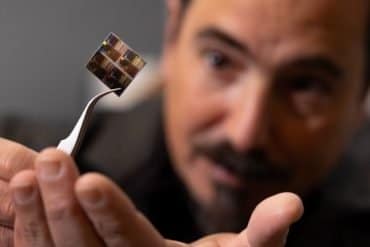Summary: Contrary to popular belief, developmental dyslexia is not caused by a structural dysfunction in the cerebral cortex, researchers report. A new study reveals developmental dyslexia is the result of a decrease in white matter connectivity between the mPT and MGB..
Source: TU Dresden.
Developmental dyslexia is one of the most widespread learning disabilities. Different therapeutic approaches and learning strategies are used to tackle the reading and writing difficulties associated with dyslexia, but to-date it is impossible to cure dyslexia. Furthermore, for many affected individuals it takes a long time until they receive a dyslexia diagnosis. Children with dyslexia have considerable problems at school and are under great emotional pressure both at school and in the family. Adults with dyslexia frequently feel ashamed of their weakness and try to hide it from their social and professional environment. But why do seemingly completely normally developed children and adults have such problems with reading and/or writing?
Many scientists think that the cause of dyslexia is a dysfunctional processing of auditory speech. However, even today, the reasons for these alterations in speech processing remain unknown. A long-standing assumption is that developmental dyslexia is caused by dysfunction of structures in the cerebral cortex.
Neuroscientist Prof. Katharina von Kriegstein from TU Dresden and an international team of experts now show in a recently published study that people with dyslexia have a weakly developed structure that is not located in the cerebral cortex, but at a subcortical processing stage; namely the white matter connectivity between the left auditory motion-sensitive planum temporale (mPT) and the left auditory thalamus (medial geniculate body. MGB).

For this study, the team headed by Prof. von Kriegstein analysed people with developmental dyslexia in comparison to people without dyslexia (control group) and conducted diagnostic tests and Magnetic Resonance Imaging (MRI) of the brain. Using special analysis techniques, the neuroscientists reconstructed the fibre structures between the mPT and the MGB. The results are the following: people with LRS have less fibre connectivity between mPT and MGB in the left hemisphere of the brain than people from the control group. The people in the control group, in contrast, showed very strong fibre connectivity between mPT and MGB, particularly those who performed extremely well in the reading test.
“Understanding the neural mechanisms of developmental dyslexia will be decisive for the development of early diagnostics and of targeted therapies. We expect our findings to initiate major novel research endeavours in the scientific community, because they show that brain structures that have thus far been insufficiently studied may be very relevant for explaining developmental dyslexia,” summarizes Prof. Katharina von Kriegstein on the success of her study.
Source: Katharina von Kriegstein – TU Dresden
Publisher: Organized by NeuroscienceNews.com.
Image Source: NeuroscienceNews.com image is in the public domain.
Original Research: Abstract for “Reduced structural connectivity between left auditory thalamus and the motion-sensitive planum temporale in developmental dyslexia” by Nadja Tschentscher, Anja Ruisinger, Helen Blank, Begoña Díaz and Katharina von Kriegstein in Journal of Neuroscience. Published January 14 2019.
doi:10.1523/JNEUROSCI.1435-18.2018
[cbtabs][cbtab title=”MLA”]TU Dresden “Neural Mechanism of Developmental Dyslexia Discovered.” NeuroscienceNews. NeuroscienceNews, 26 February 2019.
<https://neurosciencenews.com/developmental-dyslexia-mechanism-10817/>.[/cbtab][cbtab title=”APA”]TU Dresden (2019, February 26). Neural Mechanism of Developmental Dyslexia Discovered. NeuroscienceNews. Retrieved February 26, 2019 from https://neurosciencenews.com/developmental-dyslexia-mechanism-10817/[/cbtab][cbtab title=”Chicago”]TU Dresden “Neural Mechanism of Developmental Dyslexia Discovered.” https://neurosciencenews.com/developmental-dyslexia-mechanism-10817/ (accessed February 26, 2019).[/cbtab][/cbtabs]
Abstract
Reduced structural connectivity between left auditory thalamus and the motion-sensitive planum temporale in developmental dyslexia
Developmental dyslexia is characterized by the inability to acquire typical reading and writing skills. Dyslexia has been frequently linked to cerebral cortex alterations; however recent evidence also points towards sensory thalamus dysfunctions: dyslexics showed reduced responses in the left auditory thalamus (medial geniculate body, MGB) during speech processing in contrast to neurotypical readers. In addition, in the visual modality, dyslexics have reduced structural connectivity between the left visual thalamus (lateral geniculate nucleus, LGN) and V5/MT – a cerebral cortex region involved in visual movement processing. Higher LGN-V5/MT connectivity in dyslexics was associated with the faster rapid naming of letters and numbers (RANln), a measure that is highly correlated with reading proficiency. We here tested two hypotheses that were directly derived from these previous findings. First, we tested the hypothesis that dyslexics have reduced structural connectivity between the left MGB and the auditory motion-sensitive part of the left planum temporale (mPT). Second, we hypothesized that the amount of left mPT-MGB connectivity correlates with dyslexics RANln scores. Using diffusion tensor imaging based probabilistic tracking we show that male adults with developmental dyslexia have reduced structural connectivity between the left MGB and the left mPT — confirming the first hypothesis. Stronger left mPT-MGB connectivity was not associated with faster RANnl scores in dyslexics, but in neurotypical readers. Our findings provide first evidence that reduced cortico-thalamic connectivity in the auditory modality is a feature of developmental dyslexia, and that it may also impact on reading related cognitive abilities in neurotypical readers.
Significance Statement
Developmental dyslexia is one of the most widespread learning disabilities. While previous neuroimaging research mainly focused on pathomechanisms of dyslexia at the cerebral cortex level, several lines of evidence suggest an atypical functioning of subcortical sensory structures. By means of diffusion tensor imaging, we here show that dyslexic male adults have reduced white matter connectivity in a cortico-thalamic auditory pathway between the left auditory motion-sensitive planum temporale (mPT) and the left medial geniculate body (MGB). Connectivity strength of this pathway was associated with measures of reading fluency in neurotypical readers. This is novel evidence on the neurocognitive correlates of reading proficiency, highlighting the importance of cortico-subcortical interactions between regions involved in the processing of spectrotemporally complex sound.






